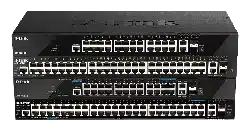Loading ...
Loading ...
Loading ...

DGS-1520 Series Gigabit Ethernet Smart Managed Switch Web UI Reference Guide
60
After clicking the Configure button, the following page will appear.
Figure 4-35 DHCP Server Pool Configure Window
The fields that can be configured are described below:
Parameter Description
Boot File
Enter the boot file name here. This can be up to 64 characters long.
Domain Name
Enter the domain name for the DHCP client here. This can be up to 64 characters
long.
Network (IP/Mask)
Enter the network IPv4 address and subnet mask for the DHCP client here.
Next Server
Enter the next server IPv4 address here. The boot image file is stored on this
server and can be retrieved by DHCP clients using this IP address. The server is
typically a TFTP server. Only one next server IP address can be specified.
Default Router
Enter the IPv4 address of the default router for the DHCP client here. Up to 8 IPv4
address can be entered here. The IP address of the router should be on the same
subnet as the client's subnet. Routers are listed in the order of preference. If
default routers are already configured, the default routers configured later will be
added to the default interface list.
DNS Server
Enter the IPv4 address to be used by the DHCP client as the DNS server here. Up
to 8 IPv4 address can be entered here. Servers are listed in the order of
preference. If DNS servers are already configured, the DNS servers configured
later will be added to the DNS server list.
NetBIOS Name Server
Enter the WINS name server IPv4 address for the DHCP client here. Up to 8 IPv4
address can be entered here. Servers are listed in the order of preference. If name
servers are already configured, the name server configured later will be added to
the default interface list.
NetBIOS Node Type
Select the NetBIOS node type for Microsoft DHCP clients here. The node type
determines the method that NetBIOS uses to register and resolve names. Options
to choose from are:
• Broadcast - The Broadcast system uses broadcasts.
• Peer To Peer - The Peer To Peer (p-node) system uses only point-to-point
name queries to a name server (WINS).
• Mixed - The Mixed (m-node) system broadcasts first, and then queries the
name server.
• Hybrid - The Hybrid (h-node) system queries the name server first, and
then broadcasts. The Hybrid type is recommended.
Lease
Enter and select the lease time for an IPv4 address that is assigned from the
address pool here. Enter the Days in the range from 0 to 365. Select the Hours
Loading ...
Loading ...
Loading ...
